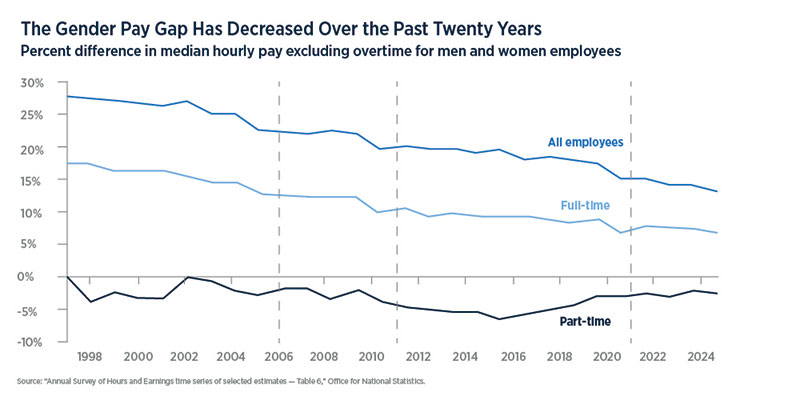Author: Sarah Jefferys
The gender pay gap has crept downward slowly in the UK since pay gap reporting requirements came into effect in 2017. According to the Office for National Statistics (ONS), the median hourly pay for full-time employees fell 7% lower for women than men in April 2024, decreasing from 7.5% in April 20231.
However, behind the headlines we see that the gender pay gap:
- Impacts employees aged 40 and older more than those younger than 40 years
- Looms larger among high earners than among lower-paid employees
- Specifically affects women, who make up most low-paid and part-time workers
 When considering the gender pay gap, organisations must recognise that women experience this inequity across a spectrum of variables. A widely diverse group, women experience the pay gap according to multiple intersecting identities. These variables often compound the inequalities and may include age, education, ethnic background, disability issues, relationship and family factors and more.
When considering the gender pay gap, organisations must recognise that women experience this inequity across a spectrum of variables. A widely diverse group, women experience the pay gap according to multiple intersecting identities. These variables often compound the inequalities and may include age, education, ethnic background, disability issues, relationship and family factors and more.
Poorly designed pay structures can damage organisations
Since the landmark Equal Pay Act of 1970, UK employers face potential legal consequences in treating men and women differently in terms of pay and working conditions. Yet more than 50 years later we’ve seen organisations, particularly those in the public and retail sectors, continue to stumble into financial and reputational hot water over gender pay discrepancies. Rather than reveal deliberate discrimination, such examples more likely point to poorly designed reward strategies and errors in data and reporting. But such unintended consequences don’t make the pay gaps any less damaging to those impacted.
That stark pay difference and the many examples of equal pay disputes we’ve observed in the market show that employers still have work to do in closing the gender pay gap. Leaders should recognise this disparity as an opportunity to develop best practices in their reward strategies, moving beyond simply reporting pay gaps. More importantly, acting on pay gaps can advance the increasingly vital environmental, social and governance (ESG) agenda and better equip organisations to attract and retain more diverse talent.
Get started now
So, how can HR and reward specialists protect their organisations and move from compliance to best practice in closing the gender pay gap? Consider four places to start:
Look beyond gender
While UK law requires organisations only to report their gender pay gaps, we advocate looking at other protected characteristics like ethnicity and disability. When you take the time to understand workforce demographics, you can apply that lens to pay data to support equal pay treatment.
Start by ensuring you have complete demographic data. After securing executive buy-in, run carefully targeted internal communications and employee survey campaigns to encourage people to disclose their personal data. Aim for a 60% to 70% response rate to ensure you have enough data for a statistically significant representation of your workforce. Professional employee survey design and deployment guidance may help to bolster engagement.
Go deep on analysis
Once you’ve collected the data, delve deeply into the analysis by applying different lenses to your data set. Consider employee age, length of service and job level as examples. These lenses will help you identify and address any practices resulting in pay gaps. Such scrutiny is less about looking for unlawful practices and more about becoming best in class for pay equity as an employer of choice.
Analysis should support an action plan to close any pay gaps. UK law does not require employers to publish an action plan and government statistics estimate only 50% of employers do so2. However, going beyond compliance sends a powerful message to internal and external stakeholders that your organization is serious about pay equality and inclusion.
Review your existing reward structures
Take a step back to critically interrogate your reward systems and processes, particularly where the data suggests you may have a problem. Review and refresh your existing pay structures and career-levelling architecture. Are the structures you developed five or 10 years ago still fit for purpose? Are they transparent and well-understood by employees and managers alike?
If you find discrepancies, develop a clear action plan
If you uncover issues, it’s time for action. You may want to conduct an equal pay audit, creating target-driven action plans or initiating a fresh career framework that all employees and managers can understand.
Such a plan might require a cultural reset emphasizing flexibility to help remove any barrier to progression. Flexible work doesn’t just support women—it attracts and retains them, creating more diverse teams. By putting rigor into a system that measures and values work consistently, your organisation demonstrates authentic support of equity and transparency.
Increasingly, governments are moving to close gender pay gaps. In 2024, global change included the following actions3:
- Canada passed the Equal Pay Transparency Act, requiring all employers to disclose salaries and gender pay gaps publicly.
- The French government expanded parental leave policies in 2024, providing equal paid leave to both mothers and fathers.
- Japan enacted the Gender Equality Advancement Law, mandating that companies with more than 300 employees achieve a 50% female representation target in management by 2030. The law also provides subsidies to companies making significant progress toward this goal.
- Germany introduced a law requiring publicly traded companies to include women in at least 30% of supervisory board seats. This move builds on previous legislation driving a steady increase in female representation in corporate leadership roles.
Gallagher can help
If Gallagher can help your organisation assess your compensation plan, contact us. Our team can help you identify equity gaps and create a plan to move past compliance to best practice, so you can better recruit and retain top talent.



